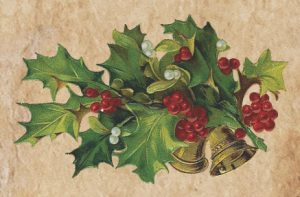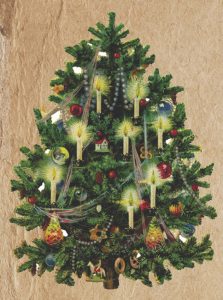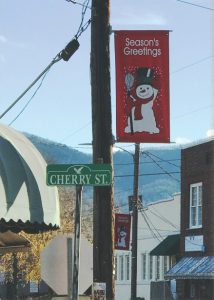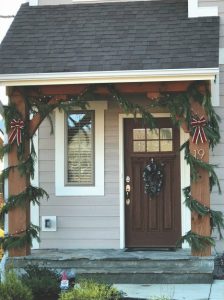The Rose Knows – December 2016
 At this time of year, the deciduous oaks, maples, elms, poplars, beeches, and sourwoods have shed their leaves allowing the evergreens to take center stage in our mountains. A plethora of cedars, balsams, Carolina hemlocks, spruces, and volumes of white, Virginia, and Scottish pines provide stability and beauty during our winter months. It is little wonder that for thousands of years, humans have carried this greenery inside as part of religious observances. And we still do.
At this time of year, the deciduous oaks, maples, elms, poplars, beeches, and sourwoods have shed their leaves allowing the evergreens to take center stage in our mountains. A plethora of cedars, balsams, Carolina hemlocks, spruces, and volumes of white, Virginia, and Scottish pines provide stability and beauty during our winter months. It is little wonder that for thousands of years, humans have carried this greenery inside as part of religious observances. And we still do.
 O Christmas Tree
O Christmas Tree
The ancients brought green foliage indoors. The Egyptians honored the Sun god Amon-Ra by filling their homes with green palm rushes symbolizing triumph of life over death. The Romans marked the Winter Solstice that honored Saturn, the god of agriculture, by bringing boughs of greenery indoors as a reminder that farms would be productive again. The ancient Celts of the British Isles and Western Europe brought evergreens into their temples as a symbol of everlasting life. The Vikings of northern Europe believed evergreens were the special plant of the Sun god, Balder.
The Christmas tree came from 16th century Germany. Legend has it, that the Protestant reformer, Martin Luther, added candles to the Christmas tree. The story goes that as he was walking home one night, he was awed by the stars twinkling amidst the evergreens. He wanted to recapture this scene, so he placed lighted candles on the Christmas tree inside his home. In the 19th century, the Christmas tree was brought to the British Isles by Queen Victoria’s husband, German Prince Consort Albert. The Christmas tree became fashionable in Britain when in 1848 the Illustrated London News published a drawing of Albert, Victoria, and their young children gathered around a decorated tree in Windsor Castle.
 The popularity of the Christmas tree then spread to the United States. Before the 19th Century, most Americans did not celebrate Christmas. The Pilgrims and Puritans deemed the celebration of Christmas a “pagan mockery” as Pilgrim Governor William Bradford put it. However, in the 1830’s German settlers erected the first recorded Christmas trees in their homes. By the 1890’s, many ornaments were arriving from Germany for floor to ceiling American trees. In the early 20th century, many Americans decorated their trees with apples, nuts, and strings of popcorn and berries. Electricity allowed lights to sparkle amidst the evergreen tree reminiscent of Luther’s twinkling stars.
The popularity of the Christmas tree then spread to the United States. Before the 19th Century, most Americans did not celebrate Christmas. The Pilgrims and Puritans deemed the celebration of Christmas a “pagan mockery” as Pilgrim Governor William Bradford put it. However, in the 1830’s German settlers erected the first recorded Christmas trees in their homes. By the 1890’s, many ornaments were arriving from Germany for floor to ceiling American trees. In the early 20th century, many Americans decorated their trees with apples, nuts, and strings of popcorn and berries. Electricity allowed lights to sparkle amidst the evergreen tree reminiscent of Luther’s twinkling stars.
Home for the Holidays
 Our own evergreen’s interspersed throughout Black Mountain serve as framing for the holiday light here at Tudor Croft. As others adorn their homes with holiday foliage, the Garretts begin to pack up for their move to Tudor Croft. The first few months of 2017 will bring many new residents to our community. One can feel the buzz of excitement as finishing touches are made on many of the homes.
Our own evergreen’s interspersed throughout Black Mountain serve as framing for the holiday light here at Tudor Croft. As others adorn their homes with holiday foliage, the Garretts begin to pack up for their move to Tudor Croft. The first few months of 2017 will bring many new residents to our community. One can feel the buzz of excitement as finishing touches are made on many of the homes.
Here and now in the 21st century, many varieties of Christmas trees grace our homes, businesses, and churches. Who among us has not been uplifted, gleeful, or felt pangs of nostalgia upon gazing upon a twinkling evergreen. Perhaps, the simple joy of the Christmas tree can serve to give us pause in our busy lives to find respite for our weary bodies, to extend grace to those around us and those far away, and to give us peace between ourselves and our God.
Welcome to Our Court!

